©
2004 Jeff Matthews & napoli.com
Copyright (1), Music (1), Neapolitan
Song (1), 'O sole mio
A couple
of items in the Neapolitan daily, Il Mattino, caught my eye yesterday.
One has
to do with the song, 'O sole mio. A judge in Torino has decided
that one Alfredo Mazzucchi (1878-1972) deserves to be listed as a co-author
of that song, along with the traditional authors, lyricist Giovanni
Capurro (1859-1929), and Eduardo di Capua (1865-1917), who composed
the melody.
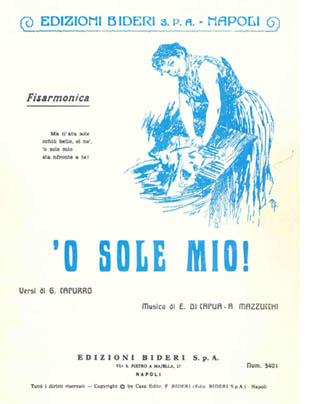 Mazzucchi
is obscure even to students of the Neapolitan Song and is usually referred
to as a "transcriber," meaning that, as a young pianist, he would show
up and work at the keyboard to help the "real" songwriters get their
ideas down on the black and white of piano keys and music manuscript.
His descendants brought suit, claiming that he had had as much to do
with many of di Capua's famous melodies as did di Capua, himself. The
judge agreed, saying that Mazzucchi's contribution to the "creative
process" is "indistinguishable" from that of di Capua, the person traditionally
regarded as the composer of the melody to 'O sole mio' . The
decision extends, as well, to 18 other popular Neapolitan songs composed
by di Capua, including Maria Marì (commonly known as Ohi,
Marì). The decision is reflected in the music credits on
the title page of the music in more recent editions (photo). Mazzucchi
is obscure even to students of the Neapolitan Song and is usually referred
to as a "transcriber," meaning that, as a young pianist, he would show
up and work at the keyboard to help the "real" songwriters get their
ideas down on the black and white of piano keys and music manuscript.
His descendants brought suit, claiming that he had had as much to do
with many of di Capua's famous melodies as did di Capua, himself. The
judge agreed, saying that Mazzucchi's contribution to the "creative
process" is "indistinguishable" from that of di Capua, the person traditionally
regarded as the composer of the melody to 'O sole mio' . The
decision extends, as well, to 18 other popular Neapolitan songs composed
by di Capua, including Maria Marì (commonly known as Ohi,
Marì). The decision is reflected in the music credits on
the title page of the music in more recent editions (photo).
Di Capua's
descendants at first contested the suit, but then backed off, perhaps
in light of the interesting copyright implications. 'O sole mio
is one of the most recorded songs in the history of the industry, but
neither Capurro nor di Capua made real money from it, having sold the
song for a one-time fee of 25 lire to Bideri, the music publishing house.
In any event, since copyright lasts 70 years beyond the death of the
composer --in this case, the last surviving coauthor, Mazzucchi-- the
song is no longer in the public domain and is protected by copyright
until 2042.
The Società
italiania autori e editori (SIAE, the Italian Society of
Authors and Editors) is the Italian version of ASCAP and takes care
of paying royalties in these cases. It will now be deciding how many
millions are to be divided which way among how many persons. I'll have
to ask a copyright lawyer, but I imagine that royalties will be retroactive,
though I don't see how Capurro's or di Capua's descendants will get
anything since both of those authors sold their original rights. (Gee,
I seem to remember showing up at Cole Porter's house one time with a
couple of tunes...)
Among the
many stories surrounding 'O sole mio, perhaps the strangest has
to do with the 1920 Olympic Games held in Antwerp, Belgium. The conductor
of the band couldn't find the music to the Royal March, the national
anthem of Italy, so he struck up 'O sole mio! After a few moments
of confusion, the crowd got the idea and stood up.
(There
was a great typo in the Il Mattino article: the Italian name
for Antwerp is "Anversa". The text referred to "the 1920 Olympics in
Aversa..." [sic]. Aversa is a small town north of Naples, most famous
as the one-time site of a notorious hospital/prison for the criminally
insane. This kind of error is not at all uncommon in the local papers.
Some years ago, one writer for Il Mattino called Princess Grace
of Monaco a "Bavarian Princess". Besides referring to the principality
on the French Riviera, "Monaco" also happens to be the Italian name
for Munich. That, of course, was not a typo -- just stupidity.)
(For more
on the Neapolitan Song, see here and here.)
The second
item in the paper that interested me was the fact that the city has
apparently run out of its printed stock of traffic ticket forms. This
is why no tickets have been written for two weeks and, no doubt, why
I got away Scot-free with doing something really illegal in my car the
other day. I intend to take advantage of this for as long as possible.
Immigration
(1)
 I
had an interesting discussion last night with the gentleman who runs
the little bar down at the corner. It was about the Nobel Prize this
year for physics. One of the winners was Riccardo Giacconi, an Italian
who has been living in the US for the last 40 years. I
had an interesting discussion last night with the gentleman who runs
the little bar down at the corner. It was about the Nobel Prize this
year for physics. One of the winners was Riccardo Giacconi, an Italian
who has been living in the US for the last 40 years.
Italy,
it seems, drives away --as immigrants-- not just the "tired, poor and
huddled masses," but great numbers of doctors and scientists. The classic
case, of course, was Enrico Fermi (photo), who went to America in the
1930s to protect his Jewish wife from Fascist Italy's racial laws.
Giacconi
said in an interview that he had left Italy in order to be able to work,
meaning that even as an up-and-coming young physicist in Italy it was
simply too hard to fight a system that keeps you from getting anywhere
unless you are somehow "connected". The guy at bar says that things
haven't changed much and trotted out numerous stories from his own experience.
He liked
my own favorite story. I ran into a young Italian doctor one time who
had just come back from an internship in the US. He told me that on
his first day in the US he was strolling on the campus of the university
hospital where he was going to be working, when an "old guy" yelled
at him from across the way: "Hey, do you play tennis?" He did and wound
up as the doubles partner of the "old guy" -- who happened to be head
of the hospital. Young doc was made to feel totally at home and welcome,
which amazed him and continues to amaze most Italians I tell that story
to. The idea that a person at the top would befriend someone just starting
out is, well, not something that happens here. In the words of the guy
at the bar, "You climb over people to get to the top and then try to
keep people from climbing over you."
Advertising (2), English usage
Enough
ESL (English as a Second Language), EFL (English as a Foreign Language),
and ESP (English for Special Purposes)! I am going to start a school
for EBL (English as a Broken Language) and use the billboard ads near
my house as a text.

First of
all, if you advertise it in English, that fact, alone, says something
like, "We are international," "We are fashionable," "We appeal to the
cosmopolitan person of today". It is entirely in keeping with the de
facto presence in the New Europe of English as an international language.
The French don't like this, but that's tough.
OK, the
one in the photo (above) is correct. But on an adjacent billboard is
a picture of a woman shaving her legs. (Only my 19th-century sense of
propriety keeps me from letting you see it!) Actually, all you see is
the woman from the hips down. She is seated and you see the bottom part
of the "fashionable" pair of shorts she is wearing. A red brand label
is visible on the shorts. Then, you don't see all of the legs, just
the part she is shaving, the upper thigh. Her delicate hand is holding
an equally delicate-looking but very modern, abstract razor that
looks like it could double for some gizmo on Star Trek. Before I saw
the text, I thought it was an ad for women's razors. Silly me. Then,
I look at the text below the ad. It reads:
No superfluous. Just Exyn. Fashion and Blue Jeans Collection.
It's all
in English. The incorrect form "no" for "not" is in the original. (In
English, "no" negates a noun, as in "No Smoking". "Not" negates an adjective,
as in "Not superfluous". In this case, Italians commonly think that
"no" is used in both cases in English. It is part of their version of
"international English". It is also the same as the Italian word "no",
to mean the opposite of "yes". It is close enough to what would be the
correct Italian negative, grammatically, in this case: "non". The word
"superfluous" is equally similar to the Italian form, "superfluo". In
Italian, thus, the expression would be "non superfluo". Why say it in
English? Well, "We are international," "We are fashionable," "We
appeal to the cosmopolitan person of today". They are selling fashionable
clothes, so it fits. If they were selling toilet plungers, probably
not. The ad continues with "just". That's not Italian, but close
enough to "giusto" to have a dual-language pun. "Giusto" means "correct"
in Italian and that might be called up in the mind of an Italian reading
the ad.
The last
part, "Fashion and Blue Jeans Collection" is fascinating. I am old enough
to remember when blue-jeans were not fashionable. They were regarded
as work clothes. You put them on to go work or play rough. "Don't wear
your good pants! Put on those old jeans!" Mommy used to say. The idea
that jeans would someday be included in a "collection" never would have
occurred to me: "Presenting Armani's new collection of Autumn jeans
at the Grand Hotel," or something like that, still amazes me. Jeans have
been elevated in a way that other American cultural icons such as rock
'n' roll and fast-food have not --that is-- elevated to a state of elegance.
This may have to do with the Italian love of the "bella figura" -- looking
good. It has nothing whatsoever to do with whether or not blue-jeans
are functional clothing. In any event, jeans are part of the cultural
invasion by the United States of the rest of the world.
So -- nothing
superfluous. The woman is shaving what is obviously superfluous pubic
hair below the line of her fashionable shorts. Whether or not a woman
shaving up there is (1) necessary, or (2) fashionable, an ad like this
works, obviously, only in those places that make cultural assumptions
about what hair is desirable and where. Message: there is nothing
superfluous about our line of clothing, either. Just Exyn: non-superfluous,
functional but good-looking and fashionable clothing.
Libraries
(1)
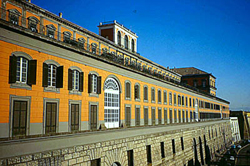 There
is only one really public library in Naples -- the National Library,
housed in the Royal Palace (photo).
Once you get past the guard and metal detector, then deposit in a tiny
locker anything extraneous on your person, such as bags and artificial
limbs, then leave the perfunctory retinal scan and urine sample, it
is no more difficult to get in than driving nails with your skull. There
is only one really public library in Naples -- the National Library,
housed in the Royal Palace (photo).
Once you get past the guard and metal detector, then deposit in a tiny
locker anything extraneous on your person, such as bags and artificial
limbs, then leave the perfunctory retinal scan and urine sample, it
is no more difficult to get in than driving nails with your skull.
Much of
the interesting material to read in Naples is held in private or university
libraries. Perhaps the strangest collection is the "La Pegna Mobile
Library" --nearly 200 boxes stored in an ex-chapel near Piazza San Domenico
Maggiore-- now converted into the Brancaccio section of the main National
Library. Each box is crammed with envelopes, each of which contains
carefully clipped out newspaper and magazine articles from the early
decades of the 20th century. The entire collection is arranged alphabetically
by subject and is the result of one journalist's (named La Pegna) obsession
with cataloguing everything he could find from the popular press of
the day. He poured his life into clipping and filing, clipping and filing.
Unfortunately, there wasn't enough room in the library to store all
the stuff, so much of it was "removed" -- a euphemism for "thrown out".
Yet, what remains is fascinating.
Monasteries
I see that
the university my wife graduated from here in Naples has started a new
degree program in art restoration. That is a good idea in a city with
as much art and history as Naples has. They have so much that it is
easy to notice the small run-down churches, closed for centuries; and
the newspapers never seem to tire of reporting how this monument is
falling apart or that building is crumbling. Yet, much of the time,
they do a good job of using their past. I am amazed, for example, at
the great number of the city's public buildings, universities, hospitals
--and even police stations-- that are in well-restored monasteries.
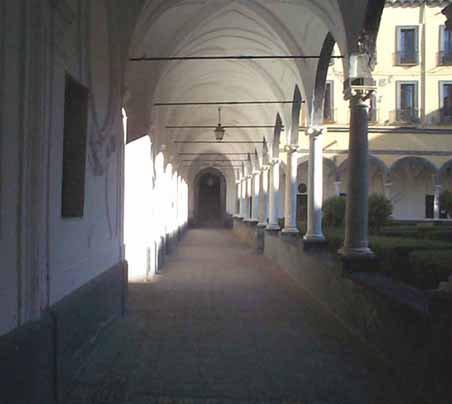 Obviously, the Protestant Reformation in the early 1500s
and the religious slaughter dryly known as the Thirty Years War (1618-48)
changed the Roman Catholic monastic tradition that had flourished in
Europe since its beginnings under St. Benedict at Monte Cassino in the
sixth century. In the 1500s and 1600s thousands of Catholic churches
and monasteries were destroyed, put out of business, or converted to
Protestantism in England and Central Europe. Those events, however,
left the heartland of the Roman Catholic faith, Italy, largely untouched.
The Vatican States were left intact and the vast Kingdom of Naples,
half of the Italian peninsula, survived the religious strife that
had wracked northern Europe. Thus, in the city of Naples in the year
1700, out of a total population of 300,000, fully one-tenth of that
number --one out of every ten Neapolitans!-- was either a priest, a
monk, or a nun living and working in the churches and adjacent monasteries
of Naples. Obviously, the Protestant Reformation in the early 1500s
and the religious slaughter dryly known as the Thirty Years War (1618-48)
changed the Roman Catholic monastic tradition that had flourished in
Europe since its beginnings under St. Benedict at Monte Cassino in the
sixth century. In the 1500s and 1600s thousands of Catholic churches
and monasteries were destroyed, put out of business, or converted to
Protestantism in England and Central Europe. Those events, however,
left the heartland of the Roman Catholic faith, Italy, largely untouched.
The Vatican States were left intact and the vast Kingdom of Naples,
half of the Italian peninsula, survived the religious strife that
had wracked northern Europe. Thus, in the city of Naples in the year
1700, out of a total population of 300,000, fully one-tenth of that
number --one out of every ten Neapolitans!-- was either a priest, a
monk, or a nun living and working in the churches and adjacent monasteries
of Naples.
That did
not change significantly until the French took over the Kingdom in 1806.
The anti-clericalism of the French Revolution closed most of monasteries
in parts of Europe that were under French control between 1795 and 1814;
that included the monasteries in Naples, which were closed by Murat's
decree of 1812. Monasteries in Naples never recovered from that, even
after the restoration of the old social order by the Congress of Vienna
in 1815. Later, the second great "suppression" of monasteries in Italy
occurred in 1864, after the unification of Italy. Thus, in Naples, though
there are still some true working monasteries left, such as Santa
Chiara, San Gregorio Armeno, and Camaldoli,
most of the grand old monasteries now serve other purposes, and it is
interesting to look at a few of these.
The City
Hall of Naples is the ex-monastery of the adjacent church of San Giacomo
(St. James) degli Spagnoli. It was built in the mid-1500s and was vast.
An inner passage connected the front of the complex to via Toledo, the
main road running behind it. That passage was closed as a result of
the construction of the new Bank of Naples in 1939. (The City Hall is
seen at left-center, at the top of the square, in the photo of Piazza Municipio.) One of the two structures on the
hill above Naples is another ex-monastery, the Museum
of San Martino. The photo at the top of this entry shows the courtyard
of the monastery of S. Maria La Nova. Administrative offices for the
city now occupy the premises. The church, itself, is still a church
and is the object of a separate entry.
Various
departments of the University of Naples
have taken over a number of former religious facilities. The Medical
School sits on the height at the old northwest corner of the city, approximately
overlooking today's Archaeological Museum and Piazza Cavour. That university
department has incorporated a number of smaller churches and cloisters
that themselves were on the sites of ancient Greek buildings. Also,
the recently restored Cloister of Saints Marcellino and Festo now houses
the Paleontology Department (click here).
The university library, itself, is behind the modern university building
and is on the premises of the old Chiostro (Cloister) del
Salvatore, an immense structure built in the 1570s that runs all
the way up the hill behind the university almost to Piazza
San Domenico Maggiore. It is still a tourist attraction because
of its so-called "courtyard of statues", a display of busts of illustrious
persons such as Bruno, Vico, and Aquinas.
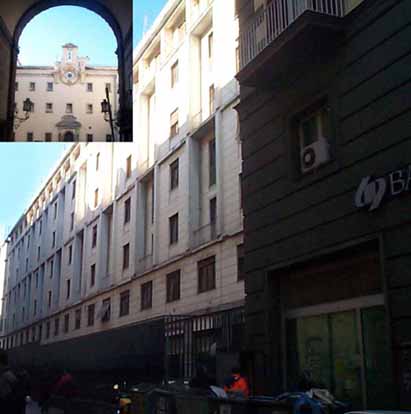 The Architecture Department of the University of Naples
is currently (2002) in the process of expanding to the premises of the
old monastery of the Church of the Spirito Santo (photo, left).
The entire complex was, indeed, vast. It was built in the mid-1500s
and the historical marker near the entrance (photo insert) on via Toledo
marks it as a "Conservatory" for the poor, reminding us of the original
meaning of that word --a place to help the poor-- and, in many cases,
"conserve" orphaned and abandoned children. (The extended meaning of
"music school" is, apparently, a Neapolitan coinage. (Click on the 'Music
Conservatory' link, below.) The Architecture Department of the University of Naples
is currently (2002) in the process of expanding to the premises of the
old monastery of the Church of the Spirito Santo (photo, left).
The entire complex was, indeed, vast. It was built in the mid-1500s
and the historical marker near the entrance (photo insert) on via Toledo
marks it as a "Conservatory" for the poor, reminding us of the original
meaning of that word --a place to help the poor-- and, in many cases,
"conserve" orphaned and abandoned children. (The extended meaning of
"music school" is, apparently, a Neapolitan coinage. (Click on the 'Music
Conservatory' link, below.)
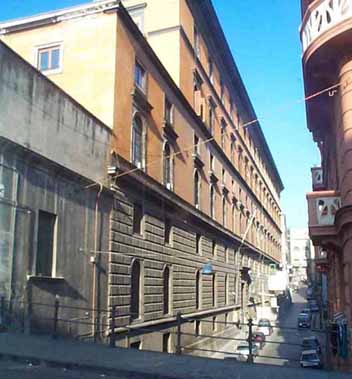 The massive building that now houses the State Archives
was originally the Benedictine monastery of Saints Severino and Sossio
(photo, right) and is in the heart of the old city, near the intersection
of Via S. Biagio dei Librai ("Spaccanapoli") and Via Duomo. The
monastery was one of the largest in the city and also one of the oldest,
dating back to the 10th century. It was also known as the "cloister
of the plane tree" as legend has it that the original building was erected
in a grove of trees of that species (platanus), a specimen of
which had been given to St. Benedict, himself. The history of the
first few centuries of the monastery remains obscure; true enlargement
of the premises started in the 1400s. Within the modern building are
to be found works of art depicting the history of the Benedictine order. Also,
the Music Conservatory, the Military barracks at Monteoliveto, the School
for Architectural Restoration, and the Monastery
of Piedigrotta are other examples of religious institutions converted
to other use, mostly in the last 100 years. The list is, indeed, long.
Perhaps we do well to look at the gradual conversion of monasteries
to other uses not so much as the result of forced closures, although
that, too, did happen. It is also a sign of the changing times. "Personal"
monasticism --that is, individuals going on religious retreats once
in a while to get away from it all-- has become somewhat fashionable
recently, but there is no doubt that large, full-time monastic orders
are an anachronism, witness the long decline in those willing to
enter upon religious callings such as the priesthood. The massive building that now houses the State Archives
was originally the Benedictine monastery of Saints Severino and Sossio
(photo, right) and is in the heart of the old city, near the intersection
of Via S. Biagio dei Librai ("Spaccanapoli") and Via Duomo. The
monastery was one of the largest in the city and also one of the oldest,
dating back to the 10th century. It was also known as the "cloister
of the plane tree" as legend has it that the original building was erected
in a grove of trees of that species (platanus), a specimen of
which had been given to St. Benedict, himself. The history of the
first few centuries of the monastery remains obscure; true enlargement
of the premises started in the 1400s. Within the modern building are
to be found works of art depicting the history of the Benedictine order. Also,
the Music Conservatory, the Military barracks at Monteoliveto, the School
for Architectural Restoration, and the Monastery
of Piedigrotta are other examples of religious institutions converted
to other use, mostly in the last 100 years. The list is, indeed, long.
Perhaps we do well to look at the gradual conversion of monasteries
to other uses not so much as the result of forced closures, although
that, too, did happen. It is also a sign of the changing times. "Personal"
monasticism --that is, individuals going on religious retreats once
in a while to get away from it all-- has become somewhat fashionable
recently, but there is no doubt that large, full-time monastic orders
are an anachronism, witness the long decline in those willing to
enter upon religious callings such as the priesthood.
Very practical
matters, as well, play a part --modern urbanization-- for example. Some
of the monasteries built in the 1500s in Naples were, at the time, on
the outskirts of the city. The Church of the Spirito Santo, mentioned
above, was outside the city wall and at the foot of a bucholic hillside.
Today, it is in downtown Naples. Even more dramatic is an institution
such as the Cloister of Suor Orsola, a convent built in the mid-1600s
halfway up the hill to San Martino at the top. When Suor Orsola was
built, there was scarcely a trail, much less a road on the hillside.
It was in the country. That section of Naples was opened to urbanization
by the construction in the mid-1800s of what has become one of the main
thoroughfares of the city, Corso Vittorio Emanuele. Since 1901, the
old convent has functioned as a women's college.
Bank
robbers, Latin
 I
hope this one is true. The paper reports that two Neapolitan bank robbers
trying to pull a heist way up north in Modena were foiled by their inability
to speak standard Italian. They explained to the teller that they had
box cutters in their pockets and were going to start slicing and dicing
if they didn't get lots of those brand new Euros --all of this in a
Neapolitan dialect about as intelligible to a bank teller in Modena
as Middle High Kurdish. After 3 or 4 more attempts, each one eliciting
from the teller responses like "I'm sorry. I don't understand you" or
"Do you want to open an account here, sir?" or "Has our automatic teller
machine outside gobbled up your credit card? Sorry. Let me call the
manager...", the speechless bad-guys fled lootless in their stolen car,
later recovered. One witness reports that on the way out of the bank,
the second thief called his spokescrook companion an idiot for not being
able to ask for money in real Italian. (See
here for an item on the Neapolitan language.) I
hope this one is true. The paper reports that two Neapolitan bank robbers
trying to pull a heist way up north in Modena were foiled by their inability
to speak standard Italian. They explained to the teller that they had
box cutters in their pockets and were going to start slicing and dicing
if they didn't get lots of those brand new Euros --all of this in a
Neapolitan dialect about as intelligible to a bank teller in Modena
as Middle High Kurdish. After 3 or 4 more attempts, each one eliciting
from the teller responses like "I'm sorry. I don't understand you" or
"Do you want to open an account here, sir?" or "Has our automatic teller
machine outside gobbled up your credit card? Sorry. Let me call the
manager...", the speechless bad-guys fled lootless in their stolen car,
later recovered. One witness reports that on the way out of the bank,
the second thief called his spokescrook companion an idiot for not being
able to ask for money in real Italian. (See
here for an item on the Neapolitan language.)
That brings
to mind a story about the great Senegalese scholar and poet, Léopold
Sédar Senghor, President of his nation from 1960-80. During his
term of office, he had occasion to pay a state visit to Italy. Unsure
of his Italian, the super-erudite Senghor addressed the Italian senate
in Latin! He was disappointed when he found out that these neo-Romans
no longer possessed even rudimentary comprehension of the language of
their forebears. The Italian press was mortified.
I was never
much of a Latin scholar at school. I did, however, study a neo-Latin
language called Spanish, but by the time the Spanish got around to the
language there were no more ablatives, datives or passive participles.
That stuff had all been replaced by bull-fights, red wine and Flamenco
babes with roses between their teeth. My kind of language.
Later,
many years out of school, I did discover an interest in Latin, however,
when I came across my first Asterix comic book. Asterix is a Celt warrior
who wages funny war against the Roman oppressors in Gaul. Depending
on where you buy your comics, Asterix speaks German or French or English,
etc. Some enterprising scholar decided to do it up right, because the
version I picked up was in Latin. I couldn't read it, of course, but
I was intrigued. Then, when I found my first Donald Duck comic in Latin,
I became aware of the growing conspiracy to resurrect what to many is
a useless language.
Useless?
Well, in many European universities as late as the 18th century, Latin
was still the language of instruction, and it was the lingua franca
of the Roman Catholic church for a long, long time. Even today, the
Vatican still generates significant numbers of documents in Latin, and,
thus, keeps scholars at work updating the language in order to be able
to deal with concepts Caesar never had to worry about. (At a recent
Vatican congress dealing with the problems of keeping the language alive,
at least as an ecclesiastical medium, reporters from RAI, the Italian
State television network, were forced to ask their questions and get
their answers in Latin. The interview was subtitled in Italian at the
bottom of the screen.) An 18,000 word dictionary of recent coinages
has recently been published by the Vatican. Some of the entries:
fax: exemplum
simillime expressum
bestseller: liber maxime divenditus
gulag: campus captivis custodiensis
car wash: autocinetorum lavatrix
pinball machine: sphaeriludium electricum nomismate actum
The internet
has a number of sites dedicated to the revival of Latin, and one local
Neapolitan I know of --who has made said revival his labor of love--
comes to the phone with "ego sum".
Food
 I
see that the First International Pasta Exhibition is opening tomorrow
down at the gigantic passenger terminal of the Port of Naples. Typically,
they will spend a lot of time talking about eating and not enough time
actually handing out free samples. I fully expect panels of self-important
sociologists to hold forth on "Societal Incorporation of Emerging Syntheses
in Higher Order Gastronomic Structures". [Also, see here] I
see that the First International Pasta Exhibition is opening tomorrow
down at the gigantic passenger terminal of the Port of Naples. Typically,
they will spend a lot of time talking about eating and not enough time
actually handing out free samples. I fully expect panels of self-important
sociologists to hold forth on "Societal Incorporation of Emerging Syntheses
in Higher Order Gastronomic Structures". [Also, see here]
No doubt
there will be some justifiable complaints about "fast food". MacDonald's
are all over and --food philistine that I am-- I have eaten there. The
main one is in the university district and is actually not a bad place
for students to sit and read. No one hassles them if they nurse a soft-drink
for an hour or so. I am reminded of at least the title of Hemingway's
short-story, A Clean Well-Lighted Place. Everyone needs a place
to sit sometimes.
There is
a local anti-fast-food society with the English name "Slow Food". They
send out invitations to their monthly affairs. You show up and spend
a half-hour or so warming up by admiring the vittles -- the texture
of this noodle or aroma of that artichoke. Ah, maccheroni 97
! --an excellent year-- with an aggressive but not presumptuous
bouquet we think will amuse you.
Halloween
 Halloween
decorations have already sprouted in shop windows in parts of Naples.
This is much too early, especially for a place that doesn't celebrate
Halloween. Witches, goblins, Walpurgisnacht, and Night on Bald Mountain
--none of that is really part of southern Italian mythology unless you
head over to the area near Benevento, where, indeed, they celebrate
the tregenda magica-- the Witches' Sabbath, a throwback to the
long presence in that area of the Lombards, a Germanic people. (Click here to read an article with more information
on the Lombards.) Halloween
decorations have already sprouted in shop windows in parts of Naples.
This is much too early, especially for a place that doesn't celebrate
Halloween. Witches, goblins, Walpurgisnacht, and Night on Bald Mountain
--none of that is really part of southern Italian mythology unless you
head over to the area near Benevento, where, indeed, they celebrate
the tregenda magica-- the Witches' Sabbath, a throwback to the
long presence in that area of the Lombards, a Germanic people. (Click here to read an article with more information
on the Lombards.)
Halloween
in Naples is simply more globalization -- this one of holidays. Northern
European and American Christmas icons, for example --Santa Claus and
Christmas trees-- are common here only since the end of W2. My mother-in-law
was living in northern Italy in WW2, where she had young German soldiers
quartered in her house. She was amazed a few days before Christmas to
see them setting up a small fir tree in her living room.
"Get that
tree out of my house!" she yelled.
"But, mamma," they said (even --or, maybe, especially-- young
German soldiers needed a mother figure), "it's Christmas!"
That didn't
make much sense to her. A tree? -- she had never heard of such
a thing before. She was from Naples and was used to the Neapolitan presepe as a symbol of the Yuletide. She
threatened to stop cooking for them and let her daughter (my wife's
sister) take over the kitchen. "Ach, nein!" was pretty much how
the Wehrmacht felt about that possibility. In retrospect, that single
act, alone, might have shortened the war by a number of months, but,
alas, a cultural rapprochement was reached. The tree stayed, and she
kept cooking.
The Bourbons (1)
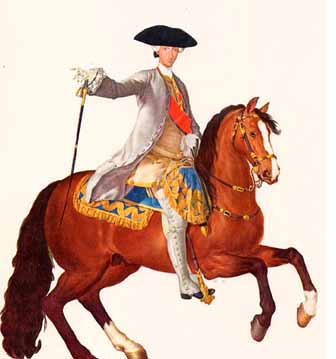
In the early 1700s the Kingdom of Naples came out of the War of the
Spanish Succession in the hands of the Hapsburgs, the royal house of
Austria. Then, the Austrians were driven from Naples by a young
prince from the Spanish branch of the House of Bourbon, to be known
upon his accession to the throne of Naples in 1734 as Charles III (painting,
left).
Naples
was an independent kingdom again for the first time in two hundred years.
After twenty-five years of rule, Charles would abdicate and return to
Spain. They say that before he left he was careful to return the crown
jewels. He even gave back a ring which he, himself, had found while
digging around Pompei, saying, "Even this ring belongs to the state".
This story, true or not, shows the regard, even veneration, that
has attached itself to this first Bourbon king of Naples. He was
paradoxically sad yet energetic, outgoing but melancholy, and he is
almost unanimously regarded as an example of the "enlightened monarch".
Charles
left impressive accomplishments: he restored some order to public finance,
curtailed church privilege, and built many now familiar, spectacular
architectural features, such as the royal palaces at Capodimonte, Portici
and Caserta. He also started the National Library, the Archaeological
Museum, a National Academy of Art and the excavations at Pompei and
Herculaneum. By the middle of the century, Naples was a capital of Enlightenment
Europe, and Antonio Genovesi, lecturing at the University, could
freely speak of redistribution of property and agrarian reform. Also,
Naples developed into a music capital of Europe, much of it performed
in the most splendid theater of its day, San Carlo.
Most of
all, perhaps, Charles encouraged the growth of a new commercial middle-class
and sought to move his subjects out of the lingering middle ages of
anachronistic class privilege and baronial abuse. Well-meaning or not,
however, he was not entirely successful in confronting this age-old
problem, which is evidence of the powerful inertia of centuries of feudalism
and of the overwhelming forces of reaction arrayed against him. In 1759
Charles returned to Spain to succeed his father on the Spanish throne.
He left Naples in the hands of his eight-year old son and a regent.
His son
Ferdinand ruled until 1825. It was to be a dynamic period: the Industrial
Revolution, the social and political theories of Rousseau and the music
of Ludwig van Beethoven. Primarily, it was the French Revolution, Napoleon,
and armies ranging over Europe on an unprecedented scale. If, from the
late 20th century, we look back at, say, the 1750's and view as 'quaint'
a scene of fat bewigged monarchs bouncing on horseback through the woods,
by 1825 the scene would change: a young Darwin would be wondering what
made the world go round and Karl Marx would already be seven years old.
It would be many things, but not 'quaint'.
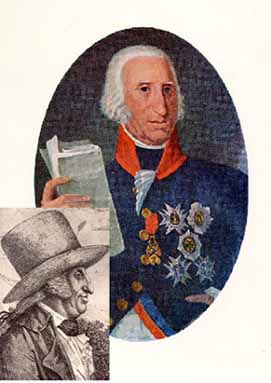
Back to 1759. Ferdinand (paintings, left) was uniquely unfit to run
a kingdom. He was a good-natured knucklehead who spoke only the local
dialect, loved to roughhouse and bandy jokes with his servant and, indeed,
felt so at home among them that he was called the "lazzarone"
king, that term (apparently from St. Lazarus, the patron saint of lepers)
being the term for any of the unwashed teeming masses. He hated to read,
but was very big on the other two Rs —riding and relaxing. Fortunately,
Charles III had left the Foreign Secretary in charge, one marquis Bernardo
Tanucci, a capable and intelligent manager. Even after the child-king
came of age in 1767, Tanucci ran the government down to the minutest
detail. He was basically concerned with conserving the cultural and
economic institutions which Charles had left in place, and he did as
good a job as possible in the face of a baronial and ecclesiastical
opposition determined to preserve its privileges.
In 1768
Ferdinand married the Archduchess Maria Carolina of Austria (painting,
below) the sister of the Emperor and the younger sister of Marie Antoinette.
She was intelligent, headstrong and utterly convinced that she had been
born to rule. She had a seat on the ruling council of Naples and set
about to make Naples into what a royal court should be, another Vienna
or Paris. She owned and treated the king like the fun-loving sheepdog
he was and during the 1770s and 1780s made Naples into less of
a marketplace of Enlightenment thought and more of a showcase of royal
glitter with cultural institutions nevertheless still worthy enough
to attract Mozart and Goethe.
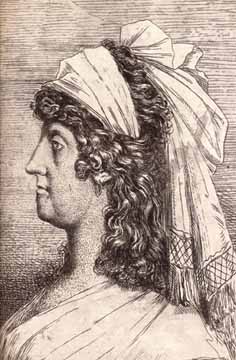 The queen forced Tanucci to resign, and she acquired
the services of John Acton, an ex-patriate
Englishman who had been commander of the naval forces of Tuscany. In
the decade before the French Revolution, Acton remade the Neapolitan
royal navy into one of the finest fleets in the Mediterranean. He opened
arms and ironworks factories, built bridges and roads and founded the
Royal Military Academy. By the time of the Revolution (1789),
he, as much as the queen, was in charge of the Kingdom of Naples. The
king was usually out hunting. The queen forced Tanucci to resign, and she acquired
the services of John Acton, an ex-patriate
Englishman who had been commander of the naval forces of Tuscany. In
the decade before the French Revolution, Acton remade the Neapolitan
royal navy into one of the finest fleets in the Mediterranean. He opened
arms and ironworks factories, built bridges and roads and founded the
Royal Military Academy. By the time of the Revolution (1789),
he, as much as the queen, was in charge of the Kingdom of Naples. The
king was usually out hunting.
When the
French Revolution started, Acton and the Queen were concerned with keeping
the kingdom safe from infection by revolutionary French ideas. Interestingly,
the masses in Naples— those who might have stood the most to gain
from storming a Bastille or two—did not seem to be interested
in throwing off their yoke. Intellectuals debated the virtues
of revolution and radical social reform, but the people, themselves,
generally liked their king and disliked anything French, even progress.
By 1793,
however, the French King Louis XVI had been beheaded, the Austrians
and French were at war, and battles were flaring up in northern Italy
as revolutionary fervor took hold. Naples agreed with the rest of European
royal opinion that the revolution had to be stemmed, and in the summer
of 1793 troops from the kingdom joined the Spanish and British
at the port of Toulon, recently taken by the British, to keep it from
being recaptured by forces of the French Republic. They failed, and
in so doing gained the dubious distinction of providing a young
artillery officer from Corsica with his first victory—and a promotion
from lieutenant to Brigadier General. By 1797, Napoleon had swept through
northern Italy, and in 1798 the French invaded the Vatican States to
set up the Roman Republic. Through their looting and violent antireligious
behavior (including the imprisonment of the Pope), they alienated the
Roman populace completely. Naples then sent troops to drive the French
from Rome. They were unsuccessful and the French counterattacked into
the kingdom. With French troops at the door and the now very real threat
of Republican insurrection from within the city of Naples, the King
and Queen fled to Sicily on Christmas of 1798.
Naples
fell after bitter fighting between Republican French troops and their
Neapolitan sympathizers on one side and the ever loyal poor lazzaroni
on the other, dedicated to their king right to the end. With the
French victory, the Parthenopean Republic was declared. Although some
have termed it a 'revolution', there is little doubt that the Republic
was imposed by force from without. The French also imposed war 'reparations'
on the new Republic, thus further antagonizing the people.
The Republic was destined to last a mere five months. The King and Queen
may have fled to Sicily, but they were not idle.
King Ferdinand
set about retaking his kingdom. He found Cardinal Ruffo, a warrior zealot who landed on the
Calabrian mainland with nothing but a flag and his own forceful personality.
Ruffo raised an army from among the tough peasantry in the surrounding
countryside as he marched north.
Depending
on who is telling the story, Ruffo's Christian Army of the Holy Faith,
the sanfedisti, were either ruthless fanatics or they were a
collection of Robin Hoods (such as the famous bandit, Fra Diavolo) loyal to their king, on a mission to
drive out foreign invaders. In fairness to Ruffo, he tried to curb the
excesses of his troops, and if they were violent, it is equally true
that their opponents, those who were dispensing Republican libertè,
fratenitè et ègalitè in the ex-kingdom of Naples
at the moment, were generally the same sort who a few years earlier
during the Terror in Paris had lopped off 2,500 heads, most of which
were guilty of little else except holding wrong thoughts. Suffice it
to say that there was barbarism on both sides as Ruffo swept north,
up through Calabria and Puglia, into Campania and towards the capital.
The tide
was now turning swiftly against the French Republic in Europe. Combined
forces of the monarchies in Britain, Russia and Austria were taking
advantage of the absence of Napoleon. He was off in Egypt during most
of 1799 attempting, and ultimately failing, to destroy British influence
in the Mediterranean. During that time, virtually all of the Republic's
advances in northern Italy, which he had brilliantly forged two years
earlier, were reversed. For Naples, the time could not have been better
for a royalist reconquest. The French pulled the main body of their
army north and left a token force in the city. With British allies under
Admiral Nelson blockading the port of Naples, Ruffo and his army entered
the city. They offered the defenders free passage if they surrendered.
They did, but Nelson, certainly at the behest of the royal family, still
in Sicily, and over the strenuous objections of Ruffo, who had given
his Christian word, had a number of the Republican defenders put to
death, including the Republican Admiral, Caracciolo, who was hanged
from the yardarm. The subsequent mass trials and executions of supporters
of the Republic are infamous. (Read about one victim, Eleonora
Fonseca Pimentel.)
Royalist
Neapolitan forces had taken advantage of a general French collapse in
Northern Italy and, indeed, the collapse of the French Republic, itself.
For a moment in late 1799, after a decade of incredible turbulence,
the monarchies of Europe saw 'the light at the end of the tunnel'. It
was a brief respite, however, for Bonaparte was back in Paris and on
November 9, 1799, he overthrew the French Directory and became First
Consul. It was notice to the princes and kings of the continent not
to get too comfortable in the imperial mantle of Charlemagne.
[continued
at Bourbons (2).]
|
